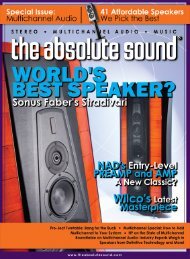Create successful ePaper yourself
Turn your PDF publications into a flip-book with our unique Google optimized e-Paper software.
TAS COVER STORY<br />
Nothing stood<br />
out in any<br />
frequency range<br />
of clarity and balance, and a silence that leaves the music floating<br />
on what sounds like real air and not a bed of fog or grain. On<br />
good recordings, nothing stood out in any frequency range, and<br />
the sweetness of the instrumental voice, any instrumental voice,<br />
had the stunning drama of a child soprano. The CD31 doesn’t<br />
have the depth that makes the midbass to bottom octave on my<br />
reference MF unit stand apart. But its lovely balance point, like a<br />
fine hairspring, held the fabric of the music under control, and the<br />
noiseless background kept the delicacies sweet while retaining the<br />
rich wash of the music. After a couple of months of listening, and<br />
rereading my notes about recent visiting amps and players, I began<br />
to think that the difference between these and other units I’ve<br />
heard under $2500 lies in that silence of the background. (The 130<br />
integrated is a true dual-mono, differential circuit design, and has<br />
other important-sounding elements that lie beyond my ken.<br />
The CD player has multiple isolated power supplies. These<br />
things may explain their golden silence. Or not.)<br />
Two recordings demonstrate well everything I have<br />
been hearing. I use Reference Recording’s Great<br />
Organ at St. Mary’s as a test for almost any piece of<br />
equipment: It lays bare the reproduction of power,<br />
clarity, frequency response, and the subtle stuff.<br />
And soundstaging, which here lies in the breadth<br />
and height of the instrument rather than side<br />
information or imaging. Some of the music is<br />
difficult—a tour of the full organ from 1600 to<br />
the late twentieth century—but it is excellently<br />
recorded, and a really good system will sort out<br />
the musical themes and elements and make<br />
the whole comprehensible to ear and brain.<br />
Throughout, the Primares let the melodies in<br />
the high ranks float out over the bassline of<br />
growling lows. Sometimes, the melody and its<br />
ornamentations dwell briefly in the big pipes, while<br />
the rhythm pulses in the highs. And those melodic<br />
lows have to be clear, clear, clear. I heard these glories<br />
in all their particularities with the Primares, as in no<br />
other modest system I know. For sheer excitement,<br />
listen to “Carillon de Westminster” by Vierne. Crank this<br />
one up—the amp can take it, if your speakers can—and you<br />
will be surrounded by flesh-trembling organ swirls.<br />
The second recording is an odd duck. I’ve found three rock or<br />
folk or whathaveyou groups whose sheer musicianship excites me:<br />
Lunasa, Nickel Creek, and the Portland, Oregon trio, Sneakin’ Out,<br />
the newest of the lot (self-described as “post-apocalyptic electro-<br />
92 December 2006 The Absolute Sound










